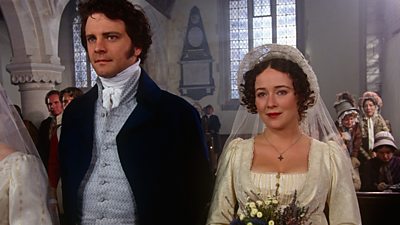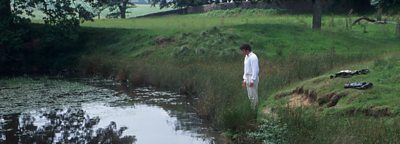Austen's Hollywood breakthrough came in 1940 with Metro-Goldwyn-Mayer’s film of Pride and Prejudice, starring Laurence Olivier as Mr Darcy and Greer Garson as Elizabeth Bennet. There were no further big-screen versions before the mid-1990s.
Her intimate and thrifty novels were long understood as more appropriate to home entertainment and domestic instruction: afternoon readings for radio and tea-time adaptations for television. Both forms were long the cultural domain of the Â鶹ԼÅÄ. Its early interpretations of Austen were, in turn, indebted to the illustrated editions of the novels marketed from the 1890s.
'Cranfordization'
The illustrator Hugh Thomson’s skilful 'Cranfordization', as it was known at the time, of the novels, through Regency details of costume and setting, established an easy familiarity with the manners of what we long took to be Jane Austen’s world. Thomson’s illustrations, directed at the adult reader, were instructive of the costumes and gestures, the talking heads, and indoor sets of stage and television productions deep into the twentieth century.
They suggested that the illusion of life her novels offer is composed of small period detail rather than romantic intrigues: 'dances and card parties and picnics, and young blokes going off to London on horseback for hair cuts and shaves'. These are the words of Humberstall, the central figure in Kipling’s extraordinary short story ‘The Janeites’ of 1924—a story that describes how reading Jane Austen (I am quite sure in illustrated editions) saved lives in the trenches of Northern France during the Great War.
This cosy, ‘Cranfordized’ image is the version of Jane Austen broadcast in the early years of Â鶹ԼÅÄ radio and up to 1950: Austen as solace in difficult times; these were wartime years.
In 1943, during the dark days of the Second World War, when Churchill famously re-read Pride and Prejudice, Rosamund Lehmann, the novelist, negotiated an agreement with the Â鶹ԼÅÄ Producer Guy Burgess to choose 'good, simple, popular passages... to read aloud' under the title 'Family Readings'. The announcement Burgess proposed for the Radio Times was:
"In this series of six readings, at fortnightly intervals on Tuesdays, the well-known English novelist, Miss Rosamund Lehmann, will choose and read the kind of passages that she, like so many other Mothers, chooses and reads to her family and friends."
For her Austen reading, Lehmann chose a passage from Emma, ch. 12, a mildly comic interlude in which the querulous Mr Woodhouse and his elder daughter, Isabella, compare anxieties over imaginary illnesses and recipes for a dish of gruel, just thick enough not to offend the stomach. Here is Austen dispensing comfort to the nation.
Enter Television
The Â鶹ԼÅÄ adaptations for television, beginning as early as 1938 with Pride and Prejudice, were inspired by radio dramatizations, obeying the same principles of fidelity to the original and reliance on dialogue. They carried over techniques from the stage: artificial indoor sets, little or no outdoor action or naturalistic setting. Cameras were fixed, shots were dominated by close ups of talking heads. Sensory effects were subordinated to a consciously theatrical dialogue and period-style aesthetic distance.
What now appears most obviously missing is the energy we associate with moving cameras, quick cuts, the openness of outdoor location filming and the intensity of a strong musical score – all features that currently identify classic novel adaptations for large and small screen. The 1980 Â鶹ԼÅÄ mini-series Pride and Prejudice, directed by Cyril Coke and with a screenplay by Fay Weldon, marked the emergence of this newer mode.
With the shift away from television’s parceling of high literature as tea-time instruction, there was a shift, too, in how we understand Austen’s style of romance—away from love as reward for the heroine’s moral education towards an open celebration of what has been called "real estate fiction" (Marjorie Garber, The Jane Austen Syndrome, 2003).
The rebranding of Austen’s novels as "real estate fiction" is one obvious consequence of filming in outdoor locations, shifting the heritage values we have always associated with her novels towards a celebration of Britain as tourist destination; still heritage, but with a different consumerist spin.
The Austen hero
Then there is the hero. It wasn’t until recent adaptations that we gave much thought to Austen’s hero as anything more than an instructor or a moral ideal. But now, thanks to Andrew Davies’s game-changing Â鶹ԼÅÄ miniseries of 1995 Pride and Prejudice, the hero has a body, physical and emotional expressiveness: he fences, swims, boxes, strips off, bathes, and he smoulders.
Our present day recognition of Austen as romantic novelist lies in such powerful imagery. It presents problems, of course: what is rendered ambivalent in the novels (the hero’s ultimate importance in the heroine’s maturing and her wider relations with society) is now shorn of almost all complexity. Such tunneled vision jettisons the sophisticated system of manipulative social relations in which the novels trade—to be replaced by more exclusive focus on the marriage or rather the sex plot.
Contemporary rebranding
Film is not novel; yet its promotional energy and interpretative agency are now impossible to disentangle from an understanding of Austen’s novels. Current adaptations are part of her rebranding as the godmother of twenty-first-century romance.
This Jane Austen is not what she once was: a writer of impeccable eighteenth-century credentials, barbed wit, and complex morality; now she is savvy, sexy and very modern. She is poised, too, for cross-species and extra-terrestrial conquests. Mash ups like Pride and Prejudice and Zombies (2016) promise a new spin on Austen’s codified societies; or rather, the fun that comes from crashing one set of established genre codes against another.
Film authenticates its own activity by drawing out what is subject to adaptation in the original and by questioning and reconfiguring ideas of property in the text. Over the last 100 years adaptation has broken through so many barriers: where will it all end?
Kathryn Sutherland is Professor of English Literature, University of Oxford, and curated major national exhibitions for the Jane Austen Bi-Centenary in Winchester and Oxford.
Jane Austen at the Â鶹ԼÅÄ
-

Jane Austen at the Â鶹ԼÅÄ - a celebration in film TV and radio
This archive compilation by Henrietta Foster traces all Â鶹ԼÅÄ TV Jane Austen TV productions. -

My Jane Austen
Henrietta Foster on delving into the Â鶹ԼÅÄ's Archive of Austen productions -

Jane Austen at the Â鶹ԼÅÄ: an Essay
Kathryn Sutherland examines the trends in Austen productions -

Pride and Prejudice
Celebrating the premiere of the series on 24 September 1995
